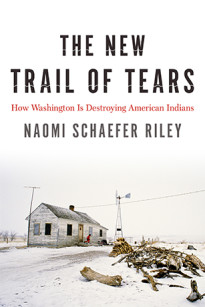In 2014, Naomi Schaefer Riley, author of the forthcoming The New Trail of Tears: How Washington Is Destroying American Indians, visited the Pine Ridge Reservation in South Dakota, which was recently granted $100,000 to boost its failing schools (Pine Ridge’s Wounded Knee elementary school had been granted $600,000 just a few years earlier).
What Riley saw there is emblematic of the core problems facing all reservation schools: nepotism and a “dysfunctional and corrupt tribal government.” She described the scene at Pine Ridge in a Wall Street Journal op-ed:
“A lot of times, the schools are the only employment places in the communities,” Alice Phelps, principal of Wounded Knee elementary, says. “The family members are employed and it’s hard to get in there and put in an improvement plan or reprimand someone, let alone put someone out of a job.”
Kiva Sam, who grew up on Pine Ridge and works for Teach for America on the reservation, says the tribe doesn’t bother to impose truancy laws. She calls the local regime “one of the most dysfunctional tribal governments in the United States,” thanks largely to “family politics.”
A few years ago, one of the students in Ms. Sam’s high-school class wasn’t showing up. She kept his mother in the loop, but he didn’t change his behavior. When it came time for graduation, Ms. Sam did not believe her student should be promoted. A member of the student’s family, however, was on the school board, and the principal said he should get his diploma. So he did.
Riley describes how Phelps assisted a third-grader with his math homework:
The first word problem that he struggled with was, “If a number rounded to the nearest hundred is 400, what is the highest number it could be?” When the student guessed 500, Ms. Phelps told him he was correct. And then she did it again with another problem.
The previous year, Ms. Phelps had fired all 10 of her teachers and rehired only two. The other eight who were let go were from Teach for America—some with Ivy League degrees, all with a commitment to help the children at Pine Ridge. But that’s not enough for tribal leaders.
When I ask Cecilia Fire Thunder, former president of the Oglala Sioux, about the teachers fired from Wounded Knee, she dismisses the controversy: “I don’t think any of them were Native.” Ms. Fire Thunder is also skeptical of Native teachers educated in universities outside the reservation, saying “they are too white. They think Western.”
Read the full article here. And learn more in The New Trail of Tears, available in July.
